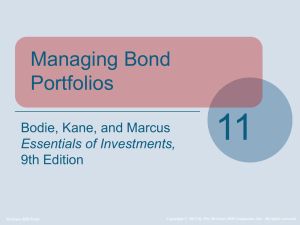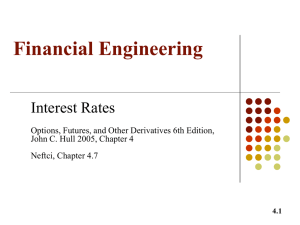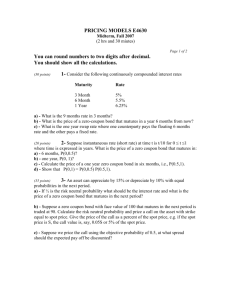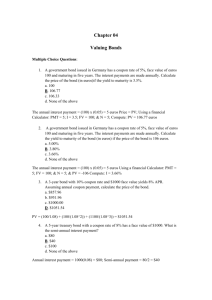chap005
advertisement
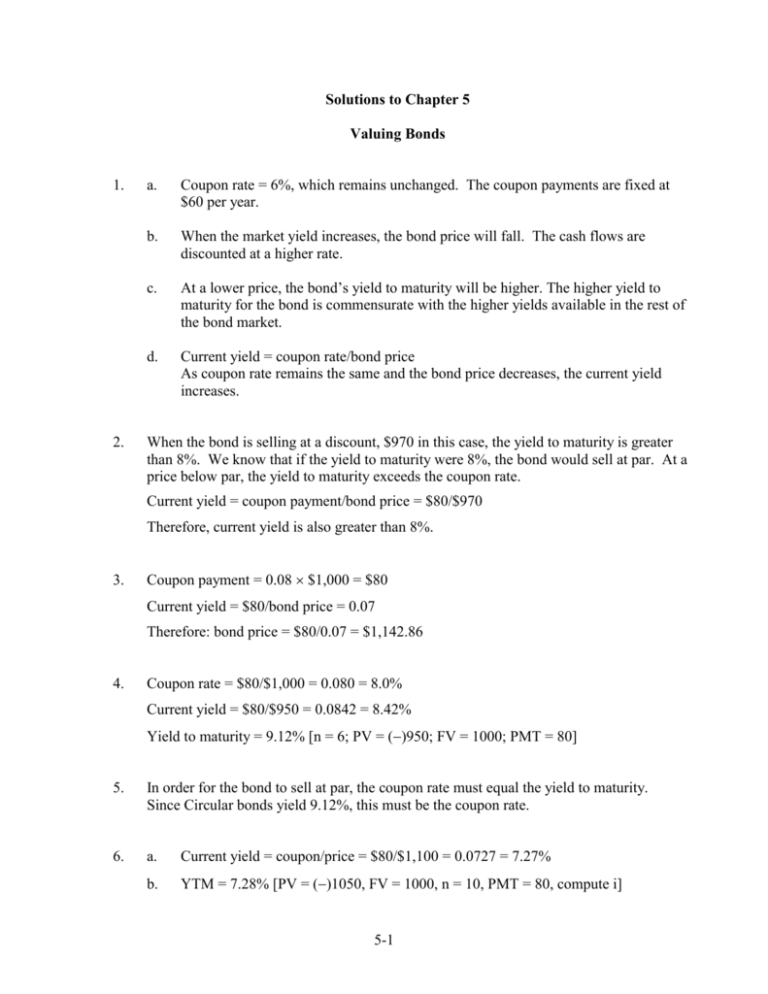
Solutions to Chapter 5 Valuing Bonds 1. 2. a. Coupon rate = 6%, which remains unchanged. The coupon payments are fixed at $60 per year. b. When the market yield increases, the bond price will fall. The cash flows are discounted at a higher rate. c. At a lower price, the bond’s yield to maturity will be higher. The higher yield to maturity for the bond is commensurate with the higher yields available in the rest of the bond market. d. Current yield = coupon rate/bond price As coupon rate remains the same and the bond price decreases, the current yield increases. When the bond is selling at a discount, $970 in this case, the yield to maturity is greater than 8%. We know that if the yield to maturity were 8%, the bond would sell at par. At a price below par, the yield to maturity exceeds the coupon rate. Current yield = coupon payment/bond price = $80/$970 Therefore, current yield is also greater than 8%. 3. Coupon payment = 0.08 $1,000 = $80 Current yield = $80/bond price = 0.07 Therefore: bond price = $80/0.07 = $1,142.86 4. Coupon rate = $80/$1,000 = 0.080 = 8.0% Current yield = $80/$950 = 0.0842 = 8.42% Yield to maturity = 9.12% [n = 6; PV = ()950; FV = 1000; PMT = 80] 5. In order for the bond to sell at par, the coupon rate must equal the yield to maturity. Since Circular bonds yield 9.12%, this must be the coupon rate. 6. a. Current yield = coupon/price = $80/$1,100 = 0.0727 = 7.27% b. YTM = 7.28% [PV = ()1050, FV = 1000, n = 10, PMT = 80, compute i] 5-1 7. When the bond is selling at face value, its yield to maturity equals its coupon rate. This firm’s bonds are selling at a yield to maturity of 9.25%. So the coupon rate on the new bonds must be 9.25% if they are to sell at face value. 5-2 8. The bond pays a coupon of 6.50% which means annual interest is $65. The bond is selling for: 107 17/32 = $1,075.3125 Therefore, the current yield is: $65/$1075.3125 = 6.04% The change from the previous day is 6/32, so the price was: 107 11/32 = $1,073.4375 9. Bond 1 year 1: PMT = 80, FV = 1000, i = 10%, n = 10; compute PV0 = 877.11 year 2: PMT = 80, FV = 1000, i = 10%, n = 9; compute PV1 = 884.82 Rate of return = $80 ($884.82 $877.11) 0.100 10.0% $877.11 Bond 2 year 1: PMT = 120, FV = 1000, i = 10%, n = 10; compute PV0 = $1,122.89 year 2: PMT = 120, FV = 1000, i = 10%, n = 9; compute PV1 = $1,115.18 Rate of Return = $120 ($1,115.18 $1,122.89) 0.100 10.0% $1,122.89 Both bonds provide the same rate of return. 10. a. b. If yield to maturity = 8%, price will be $1,000. Rate of return = coupon income price change $80 ($1,000 $1,100) 0.0182 1.82% investment $1,100 c. 11. 1 + nominal interest rate 0.9818 1 0.0468 4.68% Real return = 1 + inflation rate 1= 1.03 a. With a par value of $1,000 and a coupon rate of 8%, the bondholder receives $80 per year. b. Price = [$80 annuity factor(7%, 9 years)] + ($1,000/1.079 ) = $1,065.15 c. If the yield to maturity is 6%, the bond will sell for $1,136.03 12. Using a financial calculator, enter: n = 30, FV = 1000, PMT = 80. a. Enter PV = 900, compute i = yield to maturity = 8.971% b. Enter PV = 1,000, compute i = yield to maturity = 8.000% c. Enter PV = 1,100, compute i = yield to maturity = 7.180% 5-3 5-4 13. Using a financial calculator, enter: n = 60, FV = 1000, PMT = 40. a. Enter PV = ()900, compute i = (semiannual) YTM = 4.483% Therefore, the bond equivalent yield to maturity is: 4.483% 2 = 8.966% b. Enter PV = ()1,000, compute i = YTM = 4% Therefore, the annualized bond equivalent yield to maturity is: 4% 2 = 8% c. Enter PV = ()1,100, compute i = YTM = 3.592% Therefore, the annualized bond equivalent yield to maturity is: 3.592% 2 = 7.184% 14. In each case, we solve the following equation for the missing variable: Price = $1,000/(1 + y)maturity Price $300.00 $300.00 $385.54 Maturity (Years) 30.00 15.64 10.00 Yield to Maturity 4.095% 8.000% 10.000% 15. PV of perpetuity = coupon payment/rate of return. PV = C/r = $60/0.06 = $1,000 If the required rate of return is 10%, the bond sells for: PV = C/r = $60/0.10 = $600 16. Current yield = 0.098375 so bond price can be solved from the following: $90/Price = 0.098375 Price = $914.87 Using a financial calculator, enter: i = 10; PV = ()914.87; FV = 1000; PMT = 90, and compute n = 20 years. 17. Solve the following equation: PMT annuity factor(7%, 9 years) + $1,000/(1.07)9= $1,065.15 To solve, use a financial calculator to find the PMT that makes the PV of the bond cash flows equal to $1,065.15. You should find PMT = $80, so that the coupon rate is 8%. 5-5 18. a. The coupon rate must be 7% because the bonds were issued at face value with a yield to maturity of 7%. Now, the price is: [$70 annuity factor(15%, 8 years)] + ($1,000/1.158) = $641.01 b. The investors pay $641.01 for the bond. They expect to receive the promised coupons plus $800 at maturity. We calculate the yield to maturity based on these expectations: [$80 annuity factor(r, 8 years)] + [$800/(1+r)8] = $641.01 Using a financial calculator, enter: n = 8; PV = ()641.01; FV = 800; PMT = 70, and then compute i = 12.87% 19. a. b. At a price of $1,100 and remaining maturity of 9 years, the bond’s yield to maturity is 6.50%. Rate of return = $80 ($1,100 $980) 20.41% $980 20. PV0 = $908.71 [n = 20, PMT = 80, FV = 1000, i = 9] PV1 = $832.70 [n = 19, PMT = 80, FV = 1000, i = 10] Rate of return = $80 ($832.70 $908.71) 0.0044 0.44% $908.71 21. a, b. Price of each bond at different yields to maturity Maturity of bond 4 years 8 years 30 years Yield 7% $1,033.87 $1,059.71 $1,124.09 8% $1,000.00 $1,000.00 $1,000.00 9% $967.60 $944.65 $897.26 c. The table shows that prices of longer-term bonds are more sensitive to changes in interest rates. 22. The price of the bond at the end of the year depends on the interest rate at that time. With one year until maturity, the bond price will be: $1,080/(1 + r) a. Price = $1,080/1.06 = $1,018.87 Rate of Return = [$80 + ($1,018.87 $1,000)]/$1,000 = 0.0989 = 9.89% b. Price = $1,080/1.08 = $1,000.00 Rate of Return = [$80 + ($1,000 $1,000)]/$1,000 = 0.0800 = 8.00% 5-6 c. Price = $1,080/1.10 = $981.82 Rate of Return = [$80 + ($981.82 $1,000)]/$1000 = 0.0618 = 6.18% 23. The bond price is originally $627.73. [Using a financial calculator, enter: n = 30, PMT = 40, FV = 1000, and i = 7%, and then compute PV.] After one year, the maturity of the bond will be 29 years and its price will be $553.66. [Using a financial calculator, enter: n = 29, PMT = 40, FV = 1000, and i = 8%, and then compute PV.] The capital loss on the bond is $74.07. The rate of return is therefore: ($40 $74.07)/$627.73 = 0.0543 = 5.43% 24. The bond’s yield to maturity will increase from 7.5% to 7.8% when the perceived default risk increases. The bond price will fall: Initial price = $965.68 [n = 10, PMT = 70, FV = 1000, i = 7.5] New price = $945.83 [n = 10, PMT = 70, FV = 1000, i = 7.8] 25. The nominal rate of return is 6%. The real rate of return is: [1.06/(1 + inflation)] 1 a. 1.06/1.02 1 = 0.0392 = 3.92% b. 1.06/1.04 1 = 0.0192 = 1.92% c. 1.06/1.06 1 = 0.00 = 0% d. 1.06/1.08 1 = 0.0185 = 1.85% 26. The principal value of the bond will increase by the inflation rate, and since the coupon is 4% of the principal, the coupon will also increase along with the general level of prices. The total cash flow provided by the bond will be: 1000 (1 + inflation rate) + coupon rate 1000 (1 + inflation rate). Since the bond is purchased for face value, or $1,000, total dollar nominal return is therefore the increase in the principal due to the inflation indexing, plus coupon income: Income = [$1,000 inflation rate] + [coupon rate $1,000 (1 + inflation rate)] Finally: nominal rate of return = income/$1,000 a. Nominal rate of return = Real rate of return = $20 ($40 1.02) 0.0608 6.08% $1,000 1.0608 1 0.0400 4.00% 1.02 5-7 b. Nominal rate of return = Real rate of return = c. d. 1.0816 1 0.0400 4.00% 1.04 Nominal rate of return = Real rate of return = $60 ($40 1.06) 0.1024 10.24% $1,000 1.1024 1 0.0400 4.00% 1.06 Nominal rate of return = Real rate of return = $40 ($40 1.04) 0.0816 8.16% $1,000 $80 ($40 1.08) 0.1232 12.32% $1,000 1.1232 1 0.0400 4.00% 1.08 27. a. b. c. d. First year cash flow Second year cash flow $40 1.02 = $40.80 $40 1.04 = $41.60 $40 1.06 = $42.40 $40 1.08 = $43.20 $1,040 1.022 = $1,082.016 $1,040 1.042 = $1,124.864 $1,040 1.062 = $1,168.544 $1,040 1.082 = $1,213.056 28. The coupon bond will fall from an initial price of $1,000 (when yield to maturity = 8%) to a new price of $897.26 when yield to maturity immediately rises to 9%. This is a 10.27% decline in the bond price. $1,000 $99.38 The initial price of the zero-coupon bond is: 1.08 30 The new price of the zero-coupon bond is: $1,000 75.37 1.09 30 This is a price decline of 24.16%, far greater than that of the coupon bond. The price of the coupon bond is much less sensitive to the change in yield. It seems to act like a shorter maturity bond. This makes sense: there are many coupon payments for the 8% bond, most of which come years before the bond’s maturity date. Each payment may be considered to have its own “maturity date” which suggests that the effective maturity of the bond should be measured as some sort of average of the maturities of all the cash flows paid out by the bond. The zero-coupon bond, by contrast, makes only one payment at the final maturity date. 5-8




